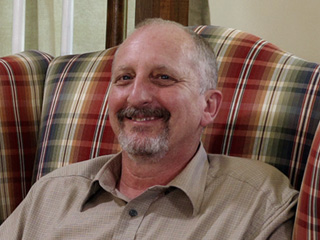A Constitutional Republic, where the First Amendment is Essential to OUR Survival
Keeping Hearts Healthy
Publisher's Note: This post appears here courtesy of ECU News Services. The author of this post is Lacey L. Gray.

Dr. Jae Won Jung, associate professor of physics, points out the side-by-side comparisons of CT scans versus his automatic segmentation technique for determining a patient's heart structure. (Photos by Rhett Butler)
New research on an image-assisted approach to radiation treatment of breast cancer conducted by East Carolina University's Dr. Jae Won Jung accurately evaluates partial radiation exposure to the heart during treatment. The research may help reduce future radiation-related heart diseases and could be used for targeted treatment of other cancers.
Jung is an associate professor of physics in the Thomas Harriot College of Arts and Sciences and has spent 10 years studying dose calculation models of radiation treatment. He has teamed with researchers at the National Cancer Institute and the University of Michigan to continue his research, and he recently received funding for equipment and student support of his project.
"One of the most important challenges for cancer survivors is the management of long-term effects of treatment," Jung said. "In radiation therapy for breast cancer, one of the potential complications is the development of radiation related heart diseases."
A recent article by Jung, published in the journal of Physics and Imaging in Radiation Oncology, describes his application of a new technique he calls automatic segmentation, which allows for quicker evaluation of a patient's heart structure.
Jung said his method for determining the structure of the patient's heart will be helpful in determining the effects of partial exposures to the heart during radiation treatment and in directing future treatment plans.
Using Jung's automatic segmentation method, an algorithm compares the computerized tomography (CT) scan of a patient's heart to a library of patient heart diagrams and identifies a best match. The algorithm is then able to provide specific contours with deformation and details of the patient's heart structure: atrium, ventricles, coronary arteries, etc.
Recently, Jung and his research team participated in the organ dosage evaluations of thousands of patients in the Radiotherapy Comparative Effectiveness (RadComp) clinical trial.
The RadComp trial compares typical photon radiation treatment with proton treatment in breast radiation therapy. Proton treatment, which generally is more expensive, is a higher dosage of radiation that is directed at the tumor, with less of the dosage going to the surrounding tissue.
Results of Jung's project will be available within the next few years.
"After our work is done, the radiation-specific dosage to heart structures will be used for epidemiology study," Jung said. "The epidemiologists will find the correlations between radiation dose to heart structures and long-term effects (i.e., increased risk of ischemic heart disease and cardiac mortality)."
According to Jung, this information could give doctors better data to prescribe patient and heart structure-specific radiation dosages for breast cancer and possibly reduce the patient's risk of future heart diseases.
"If it is used in the clinic, it will help to reduce the damage of the heart structure by limiting radiation dosage during treatment," Jung said.
This application may help protect the heart during treatments for other cancers including lung, Hodgkin's lymphoma and Wilms tumor (a type of childhood cancer that begins in the kidneys), he said.
Jung also is conducting research with his graduate students and colleagues at the Brody School of Medicine on the movement of lung tumors.
"His analysis of the movement of lung tissue around tumors has helped refine how tracking markers, used in high-dose ablative radiotherapy, are placed in and around tumors to allow for the best precision in targeting the tumors using the state-of-the-art CyberKnife system," said Dr. Andrew Ju, associate professor and chair of the Department of Radiation Oncology, who is coordinating with Jung on a separate research project.
"This effort has been particularly impactful in eastern North Carolina, where the rate of lung cancer is higher than the national average, and efforts in promoting screening CT scans for lung cancers is leading to more cancers being detected at an early stage where they are more amenable to this therapy," Ju said.
Go Back

New research on an image-assisted approach to radiation treatment of breast cancer conducted by East Carolina University's Dr. Jae Won Jung accurately evaluates partial radiation exposure to the heart during treatment. The research may help reduce future radiation-related heart diseases and could be used for targeted treatment of other cancers.
Jung is an associate professor of physics in the Thomas Harriot College of Arts and Sciences and has spent 10 years studying dose calculation models of radiation treatment. He has teamed with researchers at the National Cancer Institute and the University of Michigan to continue his research, and he recently received funding for equipment and student support of his project.
"One of the most important challenges for cancer survivors is the management of long-term effects of treatment," Jung said. "In radiation therapy for breast cancer, one of the potential complications is the development of radiation related heart diseases."
A recent article by Jung, published in the journal of Physics and Imaging in Radiation Oncology, describes his application of a new technique he calls automatic segmentation, which allows for quicker evaluation of a patient's heart structure.
Jung said his method for determining the structure of the patient's heart will be helpful in determining the effects of partial exposures to the heart during radiation treatment and in directing future treatment plans.
Using Jung's automatic segmentation method, an algorithm compares the computerized tomography (CT) scan of a patient's heart to a library of patient heart diagrams and identifies a best match. The algorithm is then able to provide specific contours with deformation and details of the patient's heart structure: atrium, ventricles, coronary arteries, etc.
Recently, Jung and his research team participated in the organ dosage evaluations of thousands of patients in the Radiotherapy Comparative Effectiveness (RadComp) clinical trial.
The RadComp trial compares typical photon radiation treatment with proton treatment in breast radiation therapy. Proton treatment, which generally is more expensive, is a higher dosage of radiation that is directed at the tumor, with less of the dosage going to the surrounding tissue.
Results of Jung's project will be available within the next few years.
"After our work is done, the radiation-specific dosage to heart structures will be used for epidemiology study," Jung said. "The epidemiologists will find the correlations between radiation dose to heart structures and long-term effects (i.e., increased risk of ischemic heart disease and cardiac mortality)."
According to Jung, this information could give doctors better data to prescribe patient and heart structure-specific radiation dosages for breast cancer and possibly reduce the patient's risk of future heart diseases.
"If it is used in the clinic, it will help to reduce the damage of the heart structure by limiting radiation dosage during treatment," Jung said.
This application may help protect the heart during treatments for other cancers including lung, Hodgkin's lymphoma and Wilms tumor (a type of childhood cancer that begins in the kidneys), he said.
Jung also is conducting research with his graduate students and colleagues at the Brody School of Medicine on the movement of lung tumors.
"His analysis of the movement of lung tissue around tumors has helped refine how tracking markers, used in high-dose ablative radiotherapy, are placed in and around tumors to allow for the best precision in targeting the tumors using the state-of-the-art CyberKnife system," said Dr. Andrew Ju, associate professor and chair of the Department of Radiation Oncology, who is coordinating with Jung on a separate research project.
"This effort has been particularly impactful in eastern North Carolina, where the rate of lung cancer is higher than the national average, and efforts in promoting screening CT scans for lung cancers is leading to more cancers being detected at an early stage where they are more amenable to this therapy," Ju said.
| Sensory Room Relaunch | East Carolina University, School News, The Region, Neighboring Counties | Delightfully Dazzling |
Latest Neighboring Counties
|
Republicans Bokhari and Driggs retain seats on city council.
Published: Tuesday, March 26th, 2024 @ 12:50 am
By: Carolina Journal
|
|
Members of the North Carolina Rural Health Association (NCRHA) visited Washington, D.C., on Feb. 14, 2024, to meet with elected officials and advocate for policies to improve access to care in rural areas.
Published: Wednesday, February 28th, 2024 @ 12:51 am
By: Eastern NC NOW Staff
|
|
The US Supreme Court will not take the case of Virginia-based owners of a Dare County beach home who challenged the county's COVID-related shutdown in 2020.
Published: Tuesday, February 6th, 2024 @ 10:14 pm
By: Carolina Journal
|
|
The North Carolina State Fair is set for the Raleigh state fairgrounds from October 12-22, 2023
Published: Friday, February 2nd, 2024 @ 9:01 am
By: Carolina Journal
|
|
A $2.5-billion-dollar bond referendum is slated to be placed on the November ballot this year, as Charlotte-Mecklenburg Schools (CMS) looks for support to fund 30 different projects in the school district.
Published: Sunday, January 14th, 2024 @ 10:08 am
By: Carolina Journal
|
|
Five Asheville-area residents are suing the city in federal court for refusing to appoint them to the local Human Relations Commission. The residents claim they were rejected because they are white.
Published: Saturday, December 9th, 2023 @ 11:53 am
By: Carolina Journal
|
|
Federal grant expands midwifery care for North Carolina
Published: Wednesday, November 29th, 2023 @ 2:59 pm
By: ECU News Services
|
|
Pirates achieve historic sponsored activities funding
Published: Tuesday, November 28th, 2023 @ 10:03 am
By: ECU News Services
|
|
Innovative new MBA pathway provides leadership experiences for students, companies
Published: Saturday, November 18th, 2023 @ 10:42 am
By: ECU News Services
|






















